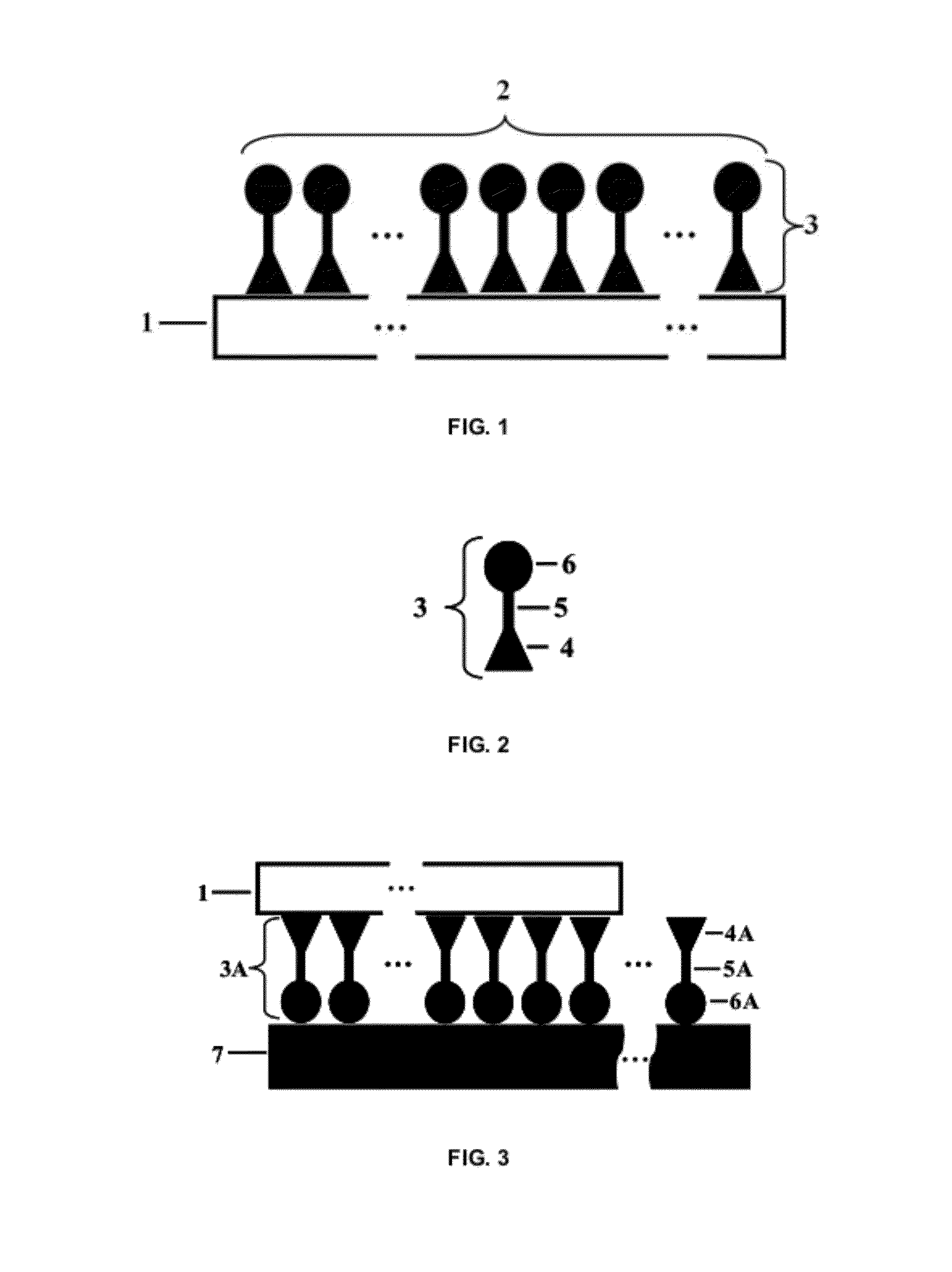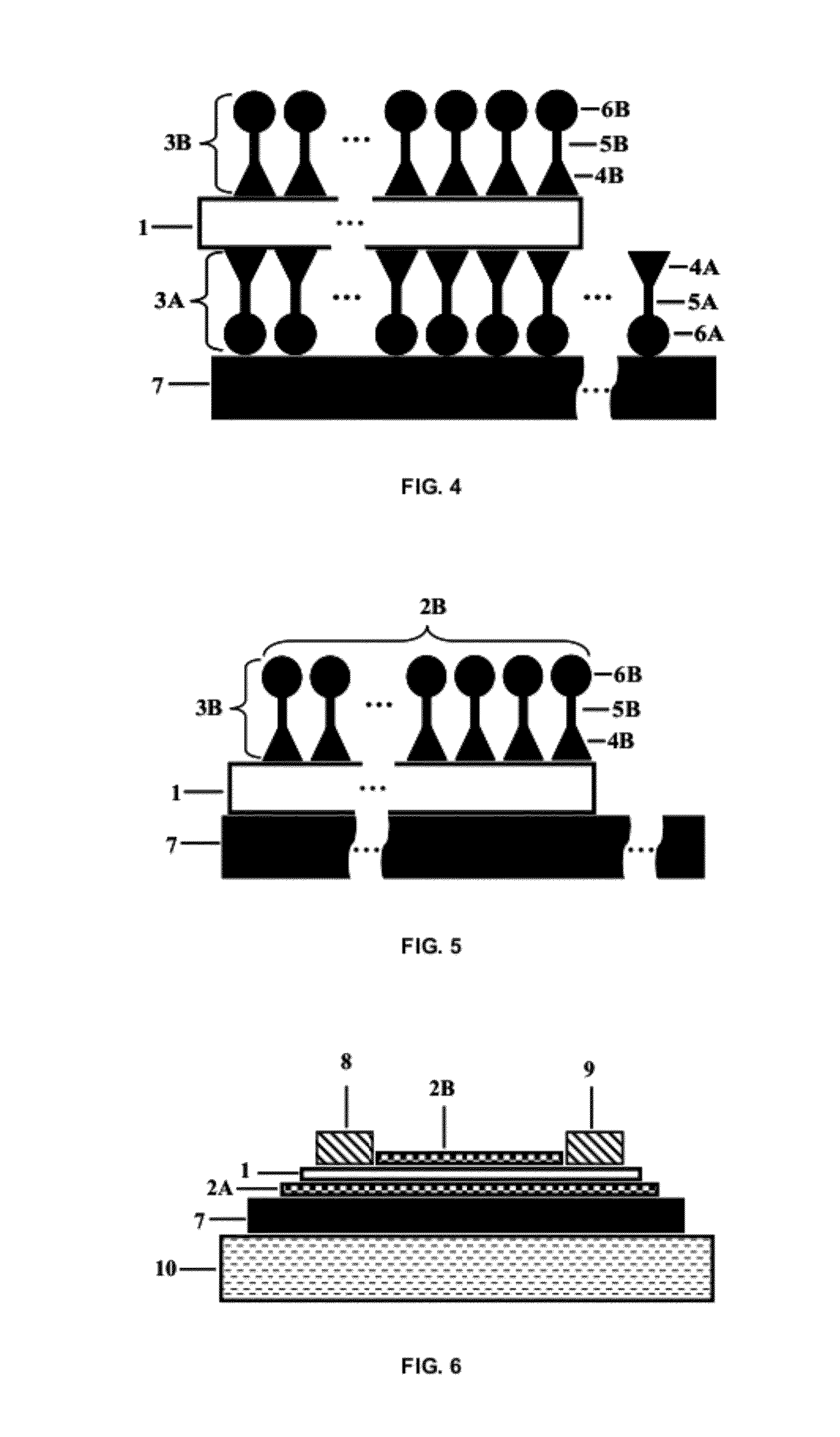Modified graphene structures and methods of manufacture thereof
a graphene structure and graphene technology, applied in the field of modified graphene structure and methods of manufacture, can solve the problems of high defect density of chemically exfoliated graphene, inability to use chemically exfoliated graphene, and inability to achieve the effect of self-assembly and stabilisation of monolayers
- Summary
- Abstract
- Description
- Claims
- Application Information
AI Technical Summary
Benefits of technology
Problems solved by technology
Method used
Image
Examples
example 1
Graphene Deposition and Functionalisation
Materials
[0116]n-doped silicon wafers were purchased from SVM Silicon Valley Microelectronics Inc, USA. Polymer resist (Shipley S1813) and Microposit resist remover (R1165) were purchased from Chestech, UK.
[0117]Aqueous solutions of citrate-stabilised gold nanoparticles were purchased from British Biocell International. UK. Three separate families of nanoparticles with different core diameters (dNP) and concentrations (cNP) were employed for different functionalisation experiments:
dNP=30 nm, cNP=2.0×1011 nanoparticles / mL
dNP=20 nm, cNP=7.0×1011 nanoparticles / mL
dNP=10 nm, cNP=5.7×1012 nanoparticles / mL
[0118]1,10-diaminodecane, 1-aminodecane, 1-aminohexane, methanol and tetrahydrofuran were purchased from Sigma-Aldrich, UK.
Full Method Protocol
1. Substrate Preparation and Cleaning
[0119]90 nm of silicon oxide was thermally grown on commercial n-doped silicon wafers using dry oxidation. The rear surface of the wafer was stripped of the oxide to enab...
example 2
Functionalisation of Graphene with Gold Nanoparticles
[0135]Silicon oxide chips bearing graphene sheets, where the top surface of graphene was functionalised with 1,10-diaminodecane made in accordance with Example 1 were immersed in a solution of citrate-stabilised gold nanoparticles (30 nm core diameter) for 6 hours. The chip was then removed and rinsed in ultra pure water before drying under a stream of nitrogen. Scanning electron microscopy (JEOL 6700F, 10 kV beam voltage) was employed to image and record the number density of nanoparticles present at the surfaces of these functionalised monolayer graphene sheets.
[0136]FIG. 11 shows a schematic of process for the functionalisation of graphene: (a) Graphene (1) on substrate (7); (b) functionalised with a layer of molecules (2) that can (c) bind gold nanoparticles (11).
Results
[0137]FIG. 11(d) is a scanning electron microscope image showing a high surface density of citrate-stabilised gold nanoparticles (30 nm core diameter) bound to...
example 3
Preparation of Graphene Field Effect Devices
[0140]A number of field effect devices were fabricated and measured as shown in FIGS. 12(a), (c), and (e).[0141]FIG. 12(a) is a field-effect device comprising a graphene layer (1) deposited on a clean thermally-grown layer of silicon oxide (7) on a doped silicon substrate (10). The silicon substrate acts as a back-gate electrode for the device.[0142]FIG. 12(c) is a schematic of the same graphene field effect device following annealing in vacuum.[0143]FIG. 12(e) is a schematic the same graphene field effect device following adsorption of a layer of functional molecules onto the graphene by immersion in a solution of 1,10-diaminodecane in methanol-tetrahydrofuran.
Field Effect Device (FIG. 12(a))
[0144]a. Graphene sheets deposited on oxidised silicon chips were electrically contacted with nickel electrodes using standard optical lithography, metal deposition and lift-off procedures.
[0145]After the deposition of the graphene by mechanical exfol...
PUM
| Property | Measurement | Unit |
|---|---|---|
| binding energy | aaaaa | aaaaa |
| thickness | aaaaa | aaaaa |
| length/width | aaaaa | aaaaa |
Abstract
Description
Claims
Application Information
 Login to View More
Login to View More - R&D
- Intellectual Property
- Life Sciences
- Materials
- Tech Scout
- Unparalleled Data Quality
- Higher Quality Content
- 60% Fewer Hallucinations
Browse by: Latest US Patents, China's latest patents, Technical Efficacy Thesaurus, Application Domain, Technology Topic, Popular Technical Reports.
© 2025 PatSnap. All rights reserved.Legal|Privacy policy|Modern Slavery Act Transparency Statement|Sitemap|About US| Contact US: help@patsnap.com



